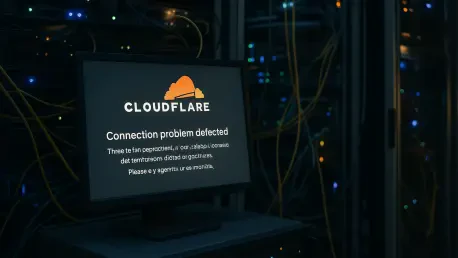Imagine a digital world grinding to a halt, where major platforms vanish from accessibility in an instant, leaving millions of users stranded and businesses reeling from unexpected losses, a scenario that became reality just a day ago. This stark situation unfolded when a massive Cloudflare outage disrupted vast swathes of the internet, impacting everything from social media to e-commerce. As a cornerstone of web security and performance, Cloudflare’s unexpected downtime sent shockwaves through the digital landscape, raising urgent questions about reliability and resilience. This roundup gathers diverse opinions, expert analyses, and practical tips from across the tech community to unpack what happened, why it matters, and how to navigate such disruptions in a hyper-connected era.
Diving into the Disruption: What Experts Are Saying
Unraveling the Technical Glitch: A Bot Management Blunder
Industry analysts have been quick to dissect the root cause of the outage, pinpointing a critical error in Cloudflare’s Bot Management system. According to technical breakdowns shared by various cybersecurity blogs, a database query misstep led to data duplication, bloating a feature file beyond its capacity and triggering a cascading system failure. This glitch, tied to automated machine learning updates, exposed a vulnerability many had overlooked until now.
Several tech commentators argue that this incident underscores a broader concern about automation in critical infrastructure. While automation boosts efficiency, some voices in the industry caution that insufficient checks on such systems can amplify small errors into global disruptions. The consensus leans toward a need for more robust manual oversight to complement automated processes.
A contrasting perspective from system architects emphasizes that the issue isn’t automation itself but rather the lack of adaptive size limits in software design. They suggest that future-proofing systems to handle unexpected data surges could prevent similar breakdowns, sparking a debate on where responsibility lies—design or deployment.
Scope of the Fallout: Who Felt the Impact?
The outage’s reach was staggering, with major platforms like ChatGPT, X, Canva, and popular online games such as League of Legends going offline, as noted by multiple user reports and tech news outlets. Contributors to online forums highlighted how even outage-tracking tools like Downdetector were inaccessible, leaving users clueless about the source of the problem. This widespread impact painted a vivid picture of digital dependency.
Some industry watchers point out that the ripple effects hit hardest in sectors like e-commerce, where platforms such as Shopify and Etsy became unavailable during peak hours. Small business owners, sharing their frustrations on social channels, described lost sales and customer trust, amplifying the narrative of economic vulnerability tied to such events.
On the other hand, gaming community leaders noted that while frustrating, the downtime offered a momentary pause for players to reconnect offline. This silver lining, though, was overshadowed by broader concerns from tech analysts about how a single point of failure can paralyze diverse industries, urging a rethink of over-reliance on centralized services.
Financial Repercussions: The Cost of Being Offline
Economic analysts across various platforms have estimated the financial damage of the outage to be between $250 million and $300 million in direct and indirect losses. Reports from business-focused publications stress that even a few hours of downtime can unravel revenue streams for companies dependent on continuous online presence, a reality that hit hard during this event.
Voices from the small business sector, echoed in community discussions, reveal a disproportionate burden on smaller entities lacking the resources to absorb such shocks. Many shared stories of disrupted transactions and delayed orders, with some consultants advising that these businesses consider contingency budgets for digital disruptions moving forward.
Conversely, larger corporations, as per insights from financial blogs, often have mitigation strategies in place but still face reputational damage. A recurring opinion among economic observers is that short outages are far from trivial, prompting calls for industry-wide standards to quantify and address downtime costs more transparently.
Recovery and Response: Varied Perspectives on Cloudflare’s Actions
Speedy Restoration: How Effective Was It?
Cloudflare’s response timeline—restoring core traffic by 2:30 PM UK time and full functionality by 5:06 PM—has drawn mixed reactions from the tech sphere. Many system administrators, commenting on professional networks, praised the rapid recovery as a testament to the company’s operational agility, noting that lingering issues for some users were largely due to traffic surges post-restoration.
However, end-user feedback on social platforms tells a different story, with complaints about inconsistent service even after the announced recovery. Some digital consultants argue that communication during the outage lacked clarity, suggesting that real-time updates could have mitigated user frustration and confusion during those critical hours.
A third angle comes from infrastructure specialists who compare this incident to past outages at providers like AWS and Microsoft Azure. They contend that while Cloudflare’s response was commendable, it highlights a systemic fragility in centralized services, with many advocating for decentralized models as a long-term solution to such risks.
Lessons for the Future: Building Stronger Safeguards
Across tech blogs and forums, there’s a strong push for actionable lessons from this disruption. Many IT professionals recommend that businesses diversify their reliance on service providers, integrating multiple layers of redundancy to cushion against single-point failures. This advice resonates particularly with startups vulnerable to operational halts.
Cybersecurity experts offer a different take, emphasizing the need for enhanced testing protocols before rolling out updates to critical systems like bot management tools. Their tip is to simulate extreme scenarios in controlled environments, a practice they believe could have flagged the data duplication issue before it escalated.
Meanwhile, a growing chorus of industry thought leaders questions whether such outages will drive innovation in backup systems. Some predict a shift toward hybrid infrastructures over the next few years, from 2025 onward, blending centralized and localized solutions to balance efficiency with resilience, a trend worth watching.
Broader Implications: Digital Dependency Under Scrutiny
The outage has ignited a wider conversation about digital fragility, with tech commentators across platforms agreeing that interconnected systems, while powerful, are inherently prone to cascading failures. This event serves as a stark illustration of how deeply the global economy is tethered to a handful of infrastructure providers, amplifying the stakes of each glitch.
Another viewpoint, shared by digital policy advocates, focuses on the societal impact of such disruptions. They argue that as reliance on internet services grows, governments and corporations must collaborate on frameworks for digital resilience, ensuring that essential services remain accessible even during widespread outages.
A final perspective from user experience researchers highlights the human element often overlooked in these discussions. They note that outages disrupt not just workflows but also trust in technology, urging companies to prioritize user-centric recovery strategies that rebuild confidence alongside technical fixes.
Reflecting on the Incident: Next Steps and Solutions
Looking back, the Cloudflare outage served as a critical wake-up call for businesses and users alike, exposing the vulnerabilities baked into the digital ecosystem. The varied insights from technical experts, economic analysts, and everyday users painted a comprehensive picture of the challenges faced during those disruptive hours. Moving forward, actionable steps emerged as a priority—businesses were encouraged to explore diversified service providers and invest in robust backup plans to weather similar storms. Additionally, the push for innovation in redundancy systems offered a hopeful glimpse into how the industry might adapt. For those navigating this connected landscape, staying informed about outage monitoring tools and crafting contingency strategies became essential takeaways from this event.









